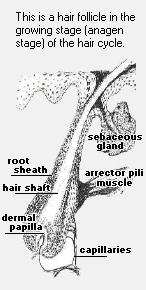
THE THREE STAGES OF THE HAIR CYCLE
1. Growing stage or Anagen - This stage lasts from two to five years. At any one time about 90% of the hair follicles are in this stage. During this stage certain cells at the base of the follicle in an area called the matrix produce the tough protein keratin of which the hair is composed.
When these cells (the keratinocytes) are working properly, they produce a hair thick in diameter. This is called a terminal hair. But when these cells are not working at their full capacity they produce a hair thin in diameter. This is called a vellus hair. It's the kind of peach fuzz you see on the scalps of men who are going bald. When the follicles spend less than the normal amount of time in the growing stage because of the influence of DHT, they tend to produce vellus hair.
2. Transitional stage or Catagen phase - This stage lasts just a week or two. At any one time only 1 - 2% of the hair follicles are in this stage. During this stage there is a rapid wrinkling and contraction of the lower part of the follicle. Keratin production ceases during this stage.
3. Resting stage or Telogen - This stage lasts between three and five months. At any one time about 10% of the hair follicles are in this stage. During this stage the old telogen hairs just rest in the now fully contracted follicle bulbs. Late in this stage these old hairs gradually start to fall out so it is not unusual for a man or a woman to lose between thirty and fifty of these hairs daily. But with healthy hair follicles, new anagen hairs replace these old telogen hairs in the next growing stage of the hair cycle.
Hair loss and premature graying of hair comes about due to various reasons. Some of these include:
- Heredity factors
- Hormonal imbalance
- Illness and infectious diseases
- Stress and anxiety
- Toxic / heavy metal poisoning
- Chemotherapy and radiation
- Insufficient Kidney energy/essence (according traditional Chinese medicine) - which can also cause premature graying of hair
WHAT IS ALOPECIA?
Alopecia areata is loss of hair on the body and is considered an autoimmune disease, in which the immune system, which is designed to protect the body from foreign invaders such as viruses and bacteria, mistakenly attacks the hair follicles, the tiny cup-shaped structures from which hairs grow. This can lead to hair loss on the scalp and elsewhere.
In most cases, hair falls out in small, round patches about the size of a quarter. In many cases, the disease does not extend beyond a few bare patches. In some people, hair loss is more extensive. Although uncommon, the disease can progress to cause total loss of hair on the head (referred to as alopecia areata totalis) or complete loss of hair on the head, face, and body (alopecia areata universalis).
Alopecia can be scarring (irreversible) and non-scarring (reversible).
Alopecia (scarring) is limited to particular areas and involves inflammation at the edge and follicle loss toward the center of lesions, violet-colored skin abnormalities, and scaling. Causes include: skin disorders, diseases, or bacterial infections
Alopecia (non-scarring) involves hair loss all over or in circular areas, receding hairline, broken hairs, smooth scalp, inflammation, and possibly loss of lashes, eyebrows, or pubic hair. Causes include: skin disorders, certain drugs, certain diseases, autoimmunity, iron deficiency, severe stress, scalp radiation, pregnancy, or pulling at your own hair
MALE-PATTERN BALDNESS (androgenic alopecia)
It is the most prominent type of hair disorder affecting, to varying degrees, half of all men over 50 years of age
The current theory about holds that in males who are genetically predisposed to baldness, certain areas of scalp tissue start to produce an enzyme called 5-alpha reductase. This enzyme converts the male hormone testosterone circulating in the blood into dihydrotestosterone or just simply DHT. Men who are prone to baldness, areas of scalp tissue (and these are the areas that become characteristically bald) start to produce 5-alpha reductase, which grabs testosterone from the blood and converts it into the potent DHT.
DHT is the culprit. DHT has an adverse affect on the hair follicles. High concentrations of DHT in the follicles cause them to spend less time in the growing stage and more time in the resting stage of the hair cycle.
- Hirsutism - male-pattern hair growth affecting eight percent of adult women comes about due to hormonal disorders. Other symptoms include irregular menstruation, lack of ovulation, acne, deepening of voice, balding, and genital abnormalities. Usually caused by excess of androgen (steroid hormone that stimulates development of male sex organs and secondary sexual characteristics). This overproduction of androgen could result from certain drugs or conditions
- Hair shaft disorders - usually hereditary abnormalities or due to inflammation and infection. Hair shaft disorders involve split ends, and hair that is dry, brittle, and coarse, as well as skin and other abnormalities. Causes include over processed hair (coloring, permanent waves, excessive heating) or certain diseases
WHO'S MOST AT RISK?
People with the following conditions or characteristics are at risk for developing hair disorders:
- Alopecia - male gender, genetic predisposition, pregnancy, physical or emotional stress, poor diet
- Hirsutism - genetic predisposition, lack of ovulation
- Hair shaft disorders - genetic predisposition, damaging grooming practices
FEMALE HAIR LOSS
Noticeable diffuse thinning in women usually starts after menopause when the production of the female hormone estrogen slows down dramatically or stops altogether. Before menopause when production of estrogen is high, this hormone has a protective effect against the small amount of testosterone that women also produce.
The enzyme 5-alpha reductase in scalp tissue converts circulating (free) testosterone into DHT. The hormone DHT (dihydrotestosterone) can harm hair follicles by making them shrink or causing them to enter prematurely into the resting stage of the hair cycle. Before menopause the estrogen in a woman's body counteracts the small amount of testosterone she produces and makes it less available to conversion into DHT.
WHAT DOES IT LOOK LIKE?
The result is usually the characteristic U-shaped pattern of hair loss. Women very rarely have this kind of hair loss. The hair loss in women is more diffuse and there are seldom any bald spots. The frontal hairline is also spared in most cases. None the less it can be devastating aesthetically.
About fifteen percent of women are afflicted with a degree of hair loss that is depressingly evident. This hair loss happens at a slower rate than in men and it happens at a much later time in life.
SUDDEN HAIR LOSS & STRICT DIETS
It is a proven scientific fact that a diet that weighs in at less than 1,200 calories a day can trigger sudden hair loss known as "Telogen effluvium".
Note: Telogen effluvium (TE) is not the same as Anagen effluvium (AE) with is sudden hair loss from chemotherapy or radiation treatments.
TELOGEN EFFLUVIUM
The type of hair loss known as TE is more common in women than in men. It Is due to many hairs entering the telogen or resting stage of the hair cycle at one time. The profuse shedding that occurs during TE can seem overwhelming to women experiencing it. The condition is often brought on by crash dieting (losing more than two pounds a week), prolonged emotional or physical stress, post-pregnancy hormone changes, and severe illness. When these triggering factors are removed, TE hair loss usually ceases. The recovery of the lost hair, however, may take six months to a year. Recovery of this kind of hair loss is probable even without treatment.
HIGH FAT DIETS CAN ENHANCE HAIR LOSS
A diet high in fat, especially fat from animal products, is thought to reduce the amount of sex hormone binding globulin (SHBG), a protein that binds to testosterone circulating in the bloodstream. This binding by the protein keeps the testosterone unavailable for conversion into DHT. With high fat diets, the amount of circulating SHBG is reduced and hence more testosterone will be available to be converted into DHT.
The body will often react to the physical stress of severely reduced calories or necessary nutrients by falling out in clumps. Diets that are especially low in protein are most suspect.
When the body is deprived of sufficient protein, through dieting or other abnormal food consumption, it will shut down all production of hair in order to divert all of its energies towards conserving vital body organs.
The body will save protein by shifting healthy hairs that are in a normal growth phase (anagen) into a sudden resting phase.
Telogen effluvium does not usually cause bald patches but it does prematurely force a much larger percentage of scalp hair into a sudden resting phase. Hair that is forced into an early resting period will almost always react by thinning and falling out.
If you are experiencing symptoms associated with a hair disorder that fit into the categories mentioned above, you should see your health care provider or naturopathic doctor, in order to identify what exactly is the root cause of your symptoms.
HAIR LOSS PREVENTION TIP
- Having a well-balanced diet and avoiding potentially damaging hair treatments can help prevent some types of hair loss
- Regular massage with various aromatherapy oils helps to improve circulation in the scalp, and improves the growth of hair, its lustre and strength
- Rinsing hair with certain types of herbal teas helps to repair early graying
HOW CAN OUR NATUROPATHIC CLINIC HELP YOU?
If you are experiencing early graying of hair or hair loss due to one or more of the reasons mentioned in the categories above, or if you are unsure what is causing your hair problems, you should see come to see our naturopathic doctor.
Your symptoms will be discussed in depth to find out what exactly is the root cause of your problems at the first visit, accompanied with a standard CBC (complete blood count) test and urine (random) test.
Our clinic offers conventionally accepted medical approaches of assessment for this condition, which include a physical exam and various laboratory tests that helps to identify the type of hair disorder and reveal any underlying diseases. In the case of hirsutism or other hormonal based problems, a hormonal panel will be done to identify what area of the endocrine system is dysfunction.
The concepts of functional medicine will also be used in your assessment, which is oriented toward determining what is impeding your body's ability to function normally. The naturopathic doctor will determine which assessment tools are most helpful in establishing a treatment strategy specific to your health needs.
The primary goals at the clinic are to identify and treat the underlying root cause, and correct damaging grooming practices.
You will be given a comprehensive treatment plan include a range of complementary and alternative therapies.
Please ask your doctor or naturopath before starting on supplements. Its better to first identify the root cause of your symptom and then treat it with the right remedies, even though those mentioned above have minimal side effects. Identifying the root cause first, using specific testing allows your naturopath to prescribe the right remedies which improves chances of success and decrease charges of disappointment and dissatisfaction.
The information on this handout is the property of Toronto Naturopath SUSHMA SHAH N.D., and is not intended to treat, diagnose or cure any disease. For any questions, or concerns, please contact me at 416 913 4325 (HEAL) or email me at [email protected]
|
|
Tweet |

